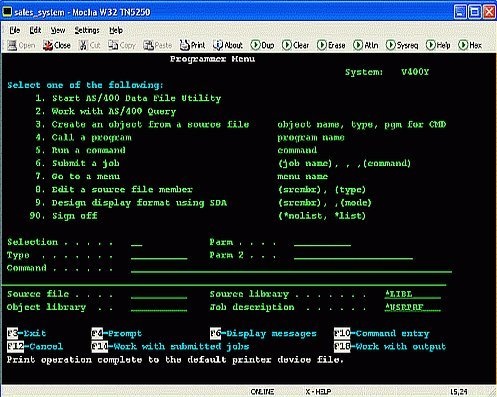

In the end, meaning, your print command is actually going thru to the server, it's just not showing you the "Print operation complete to the default printer device". I just realized it's not showing the "Print operation complete to the default printer device." But if you access your spooled jobs in your AS400 server, you should see what you've been trying to print and you probably have a TON of jobs/stuff you need to delete or remove. Hmm, I think it's actually working fine in Mocha, just with a minor aesthetic bug.
#MOCHA TN5250 CANNOT CONNECT SOFTWARE#
Some googling around looks like X print (not X-Print) is a software dependency from Mozilla for some unix/debian operating systems, unless it was supposed to come bundled along with the mocha installation. }So reading from this, is it actually supposed to be printing something or updating/refreshing the terminal from what you are describing?Ĭan you check your default printer on your Win7 Desktop? These are described in the following table:Īdding +local print key to our. On unix-like systems there are a number of arguments associated with +local print key to control how the resulting postscript is generated. +local print key will cause a print screen to be sent to the default printer when the print screen key is pressed (usually Control-P). This behaviour can be changed to have the host on which tn5250 is running do the print screen by using the +local print key argument. With the Workstation ID field blank, none of the "Avoid." options should be selected.ĭe-selecting the Avoid duplicate names with other workstations option caused the client to obtain the next available generic device name and resolved the problem.Usually pressing the print key results in the screen being printed by the iSeries. In this environment, with the Workstation ID field blank, it actually results in a device description of '#' being requested from the IBM i system for every request. When the PC5250 emulator Workstation ID parser encounters this '#' character at the end of the Workstation ID string, it replaces it with a consecutively changing letter, with the intent of creating a unique device description.


The option of "Avoid duplicate names with other workstations" causes a '#' character to be appended to the end of the Workstation ID that the session is configured for. While the intent was for the PC5250 emulator to not request a workstation ID, inadvertently this configuration caused the emulation session to always request a Workstation ID of '#', thereby allowing only one session with this configuration to connect at any time. The configuration of the session showed that the Workstation ID field is blank, and the "Avoid duplicate names with other workstations" option was checked. The session was supposed to be accepting the next available generic device name (QPADEVxxxx) and not requesting a specific device name. These messages are indicating that the device description that the PC5250 emulation client is requesting is not available on the IBM i™ system.
#MOCHA TN5250 CANNOT CONNECT WINDOWS#
An Access for Windows PC5250 session is failing to connect with message E8902 in the status bar and message CPF8902 being issued on the IBM i system.


 0 kommentar(er)
0 kommentar(er)
